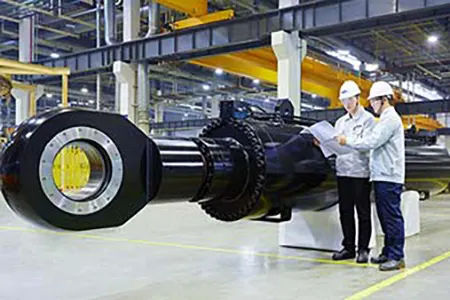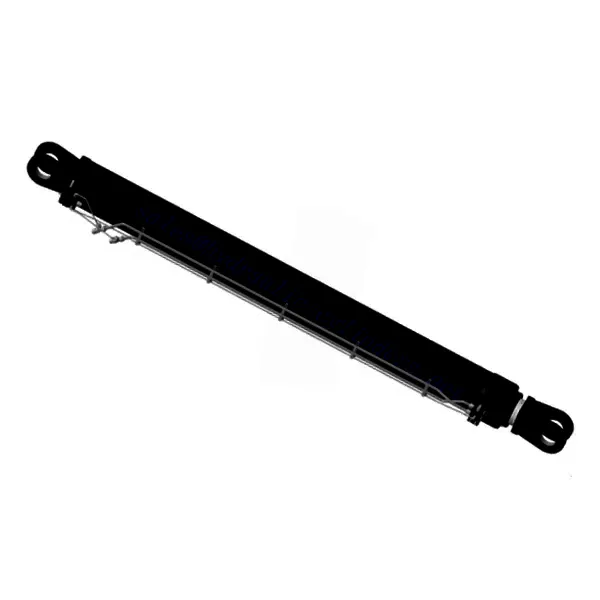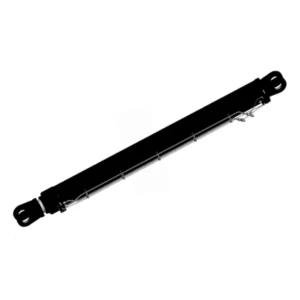Offshore Crane Folding Arm Tilt Cylinder
Jako jeden z producentów, dostawców i eksporterów produktów mechanicznych, oferujemy cylindry hydrauliczne i wiele innych produktów.
Prosimy o kontakt w celu uzyskania szczegółowych informacji.
Poczta:sales@hydraulic-cylinders.net
Producent dostawca eksporter siłowników hydraulicznych.
Offshore Crane Folding Arm Tilt Cylinder
The offshore crane folding arm tilt cylinder is a cutting-edge hydraulic component designed to optimize the performance and versatility of offshore crane systems. This specialized cylinder is specifically engineered to control the folding and tilting movements of the crane’s arms, allowing for precise load positioning and improved operational efficiency in offshore lifting operations. With its robust construction, advanced features, and ease of integration, the offshore crane folding arm tilt cylinder is an essential tool for companies seeking to enhance their offshore lifting capabilities.
Folding and tilting movements of the crane’s arms. With enhanced versatility, robust construction, and easy integration, this cylinder optimizes offshore lifting operations, enabling operators to position loads accurately and efficiently. By following the recommended usage methods and implementing regular maintenance practices, companies can maximize the performance, longevity, and safety of their offshore lifting operations. With the offshore crane folding arm tilt cylinder, businesses can enhance productivity, versatility, and safety in their offshore lifting applications, ensuring efficient and successful operations in challenging offshore environments.
Offshore Crane Latch Cylinders (mechanical self-locking) Key Characteristics:
- Precise Arm Control: The folding arm tilt cylinder enables precise control over the folding and tilting movements of the crane’s arms. This allows operators to position the load with accuracy, improving overall productivity and reducing the risk of accidents during lifting operations.
- Enhanced Versatility: The cylinder’s design enables the folding arm system to rotate horizontally and tilt vertically, providing increased flexibility in load handling. This versatility allows operators to adapt to various offshore lifting scenarios, accommodating different load sizes, shapes, and positioning requirements.
- Robust Construction: Constructed from high-quality materials, such as corrosion-resistant alloys, the Offshore Crane Folding Arm Tilt Cylinder is built to withstand the harsh offshore environment. Its durable construction ensures reliable performance and longevity, reducing maintenance needs and operational downtime.
- Easy Integration: The cylinder is designed for seamless integration into existing offshore crane systems. It can be easily installed and connected to the hydraulic circuit, utilizing the crane’s existing hydraulic power source and control system. This simplifies the installation process and minimizes downtime during the integration.
Offshore Crane Latch Cylinders (mechanical self-locking) Parameter:
| Product Name | Offshore Crane Folding Arm Tilt Cylinder |
| Features: | Provide thrust force and pulling force used to adjust the horizontal angle of the crane’s forearm |
| Bore diameter: | Up to 580mm |
| Rod diameter: | Up to 400mm Stroke up to 5170mm |
| Thrust force /Pulling force: | Maximum 8454KN/3589KN (Cylinders diameter 580mm/pressure 32MPa) |
| Applications: | Offshore Crane |
Offshore Crane Cylinder Factory:

Usage Method Of Offshore Crane Main Boom Luffing Cylinder:
- Installation: Install the offshore crane folding arm tilt cylinder in the appropriate location on the crane’s folding arm system, ensuring proper alignment and secure mounting. Follow the manufacturer’s guidelines and specifications for installation procedures, torque values, and any specific considerations for your crane system.
- Hydraulic Connections: Connect the cylinder to the hydraulic system of the offshore crane, ensuring proper routing of hydraulic lines and secure connections. Follow the manufacturer’s recommendations for hose sizes, fittings, and pressure ratings to ensure safe and efficient operation.
- Control and Operation: The folding arm tilt cylinder is typically controlled through the crane’s existing hydraulic control system. Use the control console or control panel to activate the hydraulic circuit and adjust the folding and tilting movements of the crane’s arms as required during load-handling operations.
How Do You Size A Hydraulic Cylinder?
Sizing a hydraulic cylinder involves determining the appropriate dimensions and specifications of the cylinder based on the specific application requirements. Here are the general steps to size a hydraulic cylinder:
- Determine the Load Requirements: Calculate the force or load the hydraulic cylinder must exert. This can be done by considering factors such as the object’s weight, the desired speed of movement, and any additional forces or resistance that need to be overcome.
- Calculate the Required Cylinder Area: Divide the load by the hydraulic pressure to calculate the required cylinder area. The formula is:Cylinder Area = Load / Hydraulic Pressure
Ensure the load and pressure units are consistent (e.g., pounds-force and psi).
- Select the Cylinder Bore Diameter: Using the calculated cylinder area, determine the appropriate bore diameter of the cylinder. The bore diameter is the internal diameter of the cylinder barrel and directly affects the cylinder’s force output. Refer to manufacturer catalogs or consult hydraulic engineering resources to find cylinders with suitable bore diameters.
- Consider Safety Factors: It’s essential to apply safety factors to account for any variations or uncertainties in the application. System efficiency, dynamic loads, and safety margins should be considered to ensure reliable and safe operation. Consult industry standards, guidelines, or experienced hydraulic engineers for appropriate safety factors.
- Check Cylinder Stroke Length: Determine the required stroke length of the cylinder. The stroke length is the maximum distance the cylinder’s piston can travel. Consider the range of motion needed for the application and ensure the selected cylinder stroke length can accommodate it.
- Consider Cylinder Mounting: Evaluate the hydraulic cylinder’s available space and mounting options. Consider factors such as cylinder length, rod end style (e.g., clevis, trunnion, or spherical bearing), and the required mounting configuration (e.g., flange, foot, or pivot mount). Ensure that the selected cylinder can be properly mounted in the desired location.
- Review Cylinder Specifications: Consider other specifications and features of the hydraulic cylinder, such as maximum operating pressure, operating temperature range, material compatibility, and seal options. These factors can influence the cylinder’s performance and suitability for the specific application.
- Consult Manufacturer and Application Experts: If you have complex or specialized requirements, it’s advisable to consult with hydraulic cylinder manufacturers or experienced application engineers. They can provide valuable guidance, recommend specific cylinder models, and assist in selecting the most appropriate cylinder for your application.
Możliwości i pojemność fabryki:
(1) Montaż
Dysponujemy najwyższej klasy niezależną platformą badawczo-rozwojową. Warsztat produkcji siłowników hydraulicznych posiada cztery półautomatyczne linie montażowe siłowników podnoszących i jedną automatyczną linię montażową siłowników przechyłu, o projektowanej rocznej zdolności produkcyjnej 1 miliona sztuk. Specjalny warsztat cylindrów jest wyposażony w różne specyfikacje półautomatycznego systemu montażu czyszczącego o projektowanej rocznej zdolności produkcyjnej 200 000 i wyposażony w słynny sprzęt do obróbki CNC, centrum obróbcze, specjalny sprzęt do precyzyjnej obróbki cylindrów, robot spawalniczy, automatyczna maszyna czyszcząca, automatyczna maszyna do montażu cylindrów i automatyczna linia produkcyjna do malowania. Istniejący krytyczny sprzęt składa się z ponad 300 zestawów. Optymalna alokacja i efektywne wykorzystanie zasobów sprzętowych zapewniają wymagania dotyczące dokładności produktów i spełniają potrzeby wysokiej jakości produktów.


(2) Obróbka
Warsztat obróbki skrawaniem jest wyposażony w niestandardowe centrum tokarskie z pochyloną szyną, centrum obróbcze, szybkobieżną honownicę, robota spawalniczego i inny powiązany sprzęt, który może obsługiwać przetwarzanie rur cylindrycznych o maksymalnej średnicy wewnętrznej 400 mm i maksymalnej długości 6 metrów.

(3) Spawanie

(4) Malowanie i powlekanie
Z małymi i średnimi automatycznymi liniami do powlekania farbami na bazie wody, w celu osiągnięcia automatycznego załadunku i rozładunku robota oraz automatycznego natryskiwania, wydajność projektowa 4000 sztuk na zmianę;
Posiadamy również półautomatyczną linię do produkcji farb do dużych cylindrów napędzaną łańcuchem napędowym, o wydajności 60 skrzyń na zmianę.


(5) Testowanie
Dysponujemy najwyższej klasy urządzeniami kontrolnymi i stanowiskami testowymi, aby zapewnić, że wydajność cylindra spełnia wymagania.

We are one of the best hydraulic cylinder manufacturers. We can offer comprehensive hydraulic cylinders. We also provide corresponding przekładnie rolnicze. Eksportowaliśmy nasze produkty do klientów na całym świecie i zdobyliśmy dobrą reputację dzięki najwyższej jakości produktów i usług posprzedażnych. Zapraszamy klientów w kraju i za granicą do kontaktu z nami w celu negocjacji biznesowych, wymiany informacji i współpracować z nami!
Zapraszamy na wycieczkę po naszej fabryce VR:
Wybierz się na wycieczkę po naszej fabryce VR z następującymi elementami
Jak działa siłownik hydrauliczny wózka widłowego?
Siłownik hydrauliczny Zastosowanie:



